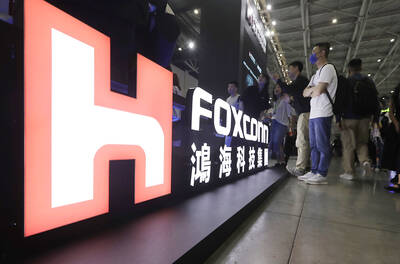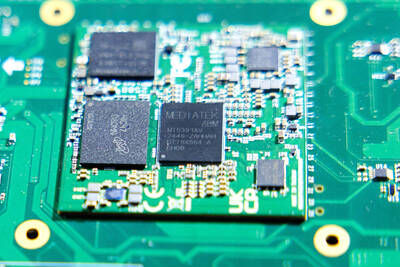Purchases of fixed assets in the domestic manufacturing sector in the fourth quarter last year posted a 69.1 percent increase to NT$695.2 billion (US$21.39 billion) from a year earlier, accelerating from the 26.8 percent increase the previous quarter, the Ministry of Economic Affairs reported on Thursday last week.
On a quarterly basis, the purchases rose 50.7 percent, which the ministry attributed to leading chip makers’ continued investments to cater to the growing demand in the artificial intelligence (AI) sector and higher requirements in production skills, further driving the expansion of production capacity in related supply chains.
The total value of fixed asset purchases last year grew 20.2 percent to NT$1.98 trillion from a year earlier, ministry data showed.

Photo: Ritchie B. Tongo, EPA-EFE
Meanwhile, revenue in the manufacturing sector in the fourth quarter last year rose 9.7 percent from a year earlier to NT$8.82 trillion, or a quarterly increase of 2.7 percent, because of the continued demand for emerging technologies such as AI, high-performance computing and cloud services, as well as the inventory stockpiling ahead of Lunar New Year holiday, the ministry said.
For the whole of last year, the sector’s revenue increased 6.3 percent year-on-year to NT$32.82 trillion, it said.
With many semiconductor makers expanding high-end chip production as well as chip packaging and testing capacity, while businesses continue investments in digital transformation and net-zero emission projects, the manufacturing sector’s investment momentum is expected to remain solid in the future, the ministry said in a statement.
However, manufacturers still need to pay attention to potential policy changes in major economies to avoid negative implications on their investment plans, it said.
The latest data showed that fixed asset purchases by electronic components makers increased 125.5 percent from a year earlier in the fourth quarter last year, at NT$496.6 billion, due to production capacity expansion from wafer foundry operators, chip packaging and testing service providers, and memorychip makers.
In the quarter, computers and optoelectronics manufacturers also increased their purchases in fixed assets by 40.1 percent, while base metal producers raised purchases by 46.1 percent, and machinery suppliers also increased by 15.6 percent, the data indicated.
The ministry attributed the purchase increase in the computers and optoelectronics sector to expansion in factories and R&D centers in response to new business opportunities created by AI. The base metal sector’s rising purchase is due to increasing investment in green energy and storage infrastructure renovation, it said.
The growing purchase in the machinery sector is due to a rising demand for semiconductor equipment and industrial automation, which has pushed related companies to purchase manufacturing facilities and expand production capacity, the ministry said.
However, purchases suffered an annual 6.5 percent decrease in the chemical materials and fertilizer sector in the fourth quarter last year, as capacity expansion at several wafer fabs was nearly completed and also due to a higher comparison base the previous year, it added.

On Ireland’s blustery western seaboard, researchers are gleefully flying giant kites — not for fun, but in the hope of generating renewable electricity and sparking a “revolution” in wind energy. “We use a kite to capture the wind and a generator at the bottom of it that captures the power,” said Padraic Doherty of Kitepower, the Dutch firm behind the venture. At its test site in operation since September 2023 near the small town of Bangor Erris, the team transports the vast 60-square-meter kite from a hangar across the lunar-like bogland to a generator. The kite is then attached by a

Foxconn Technology Co (鴻準精密), a metal casing supplier owned by Hon Hai Precision Industry Co (鴻海精密), yesterday announced plans to invest US$1 billion in the US over the next decade as part of its business transformation strategy. The Apple Inc supplier said in a statement that its board approved the investment on Thursday, as part of a transformation strategy focused on precision mold development, smart manufacturing, robotics and advanced automation. The strategy would have a strong emphasis on artificial intelligence (AI), the company added. The company said it aims to build a flexible, intelligent production ecosystem to boost competitiveness and sustainability. Foxconn

Leading Taiwanese bicycle brands Giant Manufacturing Co (巨大機械) and Merida Industry Co (美利達工業) on Sunday said that they have adopted measures to mitigate the impact of the tariff policies of US President Donald Trump’s administration. The US announced at the beginning of this month that it would impose a 20 percent tariff on imported goods made in Taiwan, effective on Thursday last week. The tariff would be added to other pre-existing most-favored-nation duties and industry-specific trade remedy levy, which would bring the overall tariff on Taiwan-made bicycles to between 25.5 percent and 31 percent. However, Giant did not seem too perturbed by the

TARIFF CONCERNS: Semiconductor suppliers are tempering expectations for the traditionally strong third quarter, citing US tariff uncertainty and a stronger NT dollar Several Taiwanese semiconductor suppliers are taking a cautious view of the third quarter — typically a peak season for the industry — citing uncertainty over US tariffs and the stronger New Taiwan dollar. Smartphone chip designer MediaTek Inc (聯發科技) said that customers accelerated orders in the first half of the year to avoid potential tariffs threatened by US President Donald Trump’s administration. As a result, it anticipates weaker-than-usual peak-season demand in the third quarter. The US tariff plan, announced on April 2, initially proposed a 32 percent duty on Taiwanese goods. Its implementation was postponed by 90 days to July 9, then